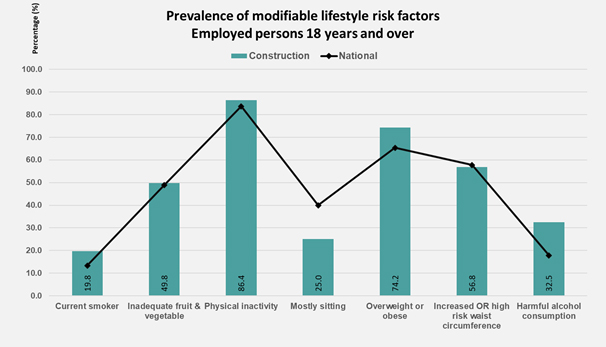National Health Survey construction industry data released
The recently released Australian National Health Survey 2017-2018 highlights that construction industry workers, compared to workers in other industries, have higher rates of smoking and alcohol consumption.
Over the past ten years there have been some positive signs of construction workers smoking less, being more physically active and consuming less alcohol. However, levels of poor nutrition, and being overweight and obese continue to rise within the industry.

2017-18 National Healthy Survey: Prevalence of modifiable risk factor results for industry
The way we work is changing, with increased automation, interaction with technology and more sedentary work - and the way risk is perceived by workers and management can lead to health issues and diseases because they are not immediately visible or have a long latency.
There is no question that the general physical and psychological health of a workforce has a direct impact on work health, safety and wellbeing. Knowledge, though, of what good health looks like and how to stay healthy is an issue, with workers and management not knowing the best way to manage health and wellbeing on site.
Workers who are regularly exposed to hazardous working conditions, physically demanding tasks, high levels of stress and long working hours are more likely to smoke, consume too much alcohol, have low levels of physical activity and poor nutrition. Workers who suffer from physical or mental health problems are likely to have higher injury, illness, absenteeism and presenteeism rates.
Using an integrated approach to work health, combining occupational safety and injury prevention, together with health and wellbeing, will enhance worker health and assist in the prevention of work-related injuries and illness.
Workplace Health and Safety Queensland recently released the Work health and wellbeing toolkit. The toolkit uses a risk management approach to help organisations identify and manage lifestyle related chronic disease risk factors.
The tools and resources in the toolkit can be used to target health risks so that elimination of risks and engineering solutions take precedence, in tandem with PPE and administration controls.
Further information
For more information or assistance, contact Workplace Health and Safety Queensland at healthyworkers@oir.qld.gov.au.